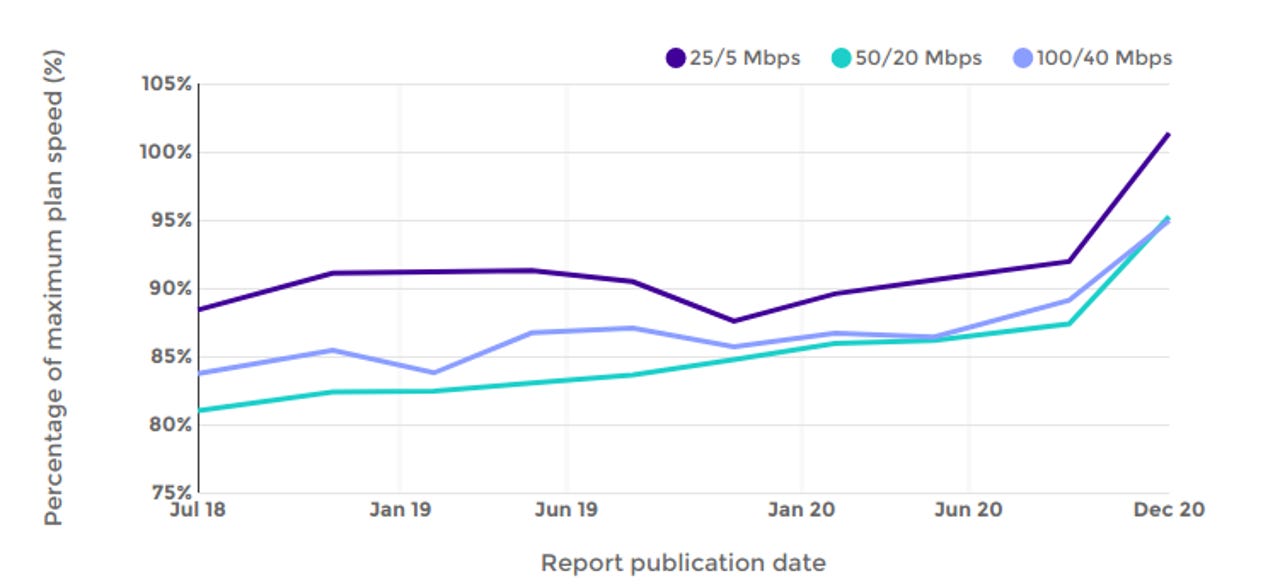NBN overprovisioning makes lowest two speed tiers faster than advertised


Thanks to the National Broadband Network (NBN) overprovisioning its plans by between 10% and 15%, it is very likely that customers on NBN's lowest two fixed-line speed tiers -- 12Mbps and 25Mbps -- are getting speeds faster than what is on the label.
According to the latest Measuring Broadband Australia report released by the Australian Competition and Consumer Commission (ACCC), the average speed was 101.2% of the labelled speed across 5,142 tests on 12Mbps lines, and 101.4% of the so-called 25Mbps label across almost 20,000 tests.
"Prior to this change, an NBN100 service would have been provisioned at slightly above 100Mbps plan speed; after protocol overhead, the highest speed test result which we could have measured might have been around 94Mbps," the report said.
"After the change, the same service might have been provisioned at above 100Mbps plan speed, meaning that even after protocol overheads we might still measure speeds around or slightly above 100Mbps. The increase in CVC has meant that there is sufficient capacity for RSPs to deliver speeds that are very close to the maximum set download speed."
However, as the speeds increased, the percentages dropped. For 50Mbps, it dropped to 95.2% on average and went down to 94.5% in busy hours, and for 100Mbps the drops were more severe, 95% overall and 94.1% in busy hours, respectively.
Overall, a majority of tests conducted for the report now sit at over 100%, with a plurality being over 105% of the plan speed.
At the 50Mbps speed tier, the ACCC reported fibre to the curb was able to outperform a full fibre connection, but once the speeds were lifted to 100Mbps, fibre to the premise was the only technology to clear 100%. HFC got close and it did surpass the 100% mark once underperforming lines were excluded.
Once again, there was little good news for fibre-to-the-node (FttN) users, even as the percentage of underperforming services dropped to sit at 8%.
"Within the 50/20Mbps NBN speed tier, fibre to the node services had an average download speed around 5Mbps lower than other technologies," the report said. "Within the 100Mbps NBN speed tiers, fibre-to-the-node services had an average download speed around 17 Mbps lower than other technologies."
Even on the overprovisioning front, the report said FttN fell short.
"Following the higher incidence of over-provisioning, all technology/plan combinations have seen an increase in download performance. Fibre to the node services on the NBN100 plan saw a relatively modest 1.9 percentage point increase in download performance, whereas other technology/plan combinations saw increases ranging from 7.1 to 10.0 percentage points," it said.
Telstra previously spun the increases in artificial capacity restriction as a speed boost, although in its defence, the telco is now advertising it can hit the labelled speed at all periods through the day, and managed to hit 103% of advertised speeds in busy hours.
All other telcos advertise in a range between 79% of plan speed for Exetel, up to 90% for Optus -- however Optus is able to hit just shy of 105% in the test, meaning it is still the fastest telco on average.
At the other end of the table, MyRepublic continues to have far and away the worst latency on offer at 21.1ms in busy periods, with Superloop taking the title of telco with the lowest latency at 10ms, followed by Aussie Broadband at 10.1 in busy hours.
"It should be noted that latency at even 30ms would have a detrimental effect on only the most latency-sensitive applications and would be unlikely to be noticed by an end user," the report said.
The ACCC also released its latest quarterly update on Friday, which included the performance of fixed wireless connections for the first time. Users on fixed wireless have the choice of a 25Mbps plan, or a best effort 25-50Mbps service dubbed Fixed Wireless plus.
"During all hours, performance of the 25Mbps plan is more stable with a daily average value of around 20Mbps. During busy hours, performance of both plans is lower and variability in daily performance is slightly higher," the update said.
"The Fixed Wireless Plus plan shows an increase in average speed, increasing from a daily average value of 35Mbps at the beginning of August to an average of around 40Mbps at the end of October."
Average daily fixed wireless download speeds during all hours